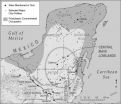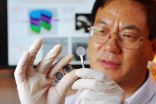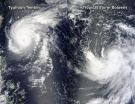(Press-News.org) TEMPE, Ariz. — A new analysis of complex interactions between humans and the environment preceding the 9th century collapse and abandonment of the Central Maya Lowlands in the Yucatán Peninsula points to a series of events — some natural, like climate change; some human-made, including large-scale landscape alterations and shifts in trade routes — that have lessons for contemporary decision-makers and sustainability scientists.
In their revised model of the collapse of the ancient Maya, social scientists B.L. "Billie" Turner and Jeremy "Jerry" A. Sabloff provide an up-to-date, human-environment systems theory in which they put together the degree of environmental and economic stress in the area that served as a trigger or tipping point for the Central Maya Lowlands.
The co-authors described the Classic Period of the Lowland Maya (CE 300-800) as a "highly complex civilization organized into networks of city-states," in their perspective article published Aug. 21 in the online Early Edition of the Proceedings of the National Academy of Sciences.
The ancient Maya in this hilly and riverless region confronted long-term climatic aridification, experienced decadal to century-level or longer droughts amplified by the landscape changes that they made, including large-scale deforestation indicated in the paleoecological record.
Previous to the collapse, the Maya occupied the area for more than 2,000 years, noted the authors, "a time in which they developed a sophisticated understanding of their environment, built and sustained intensive production [and water] systems, and withstood at least two long-term episodes of aridity."
They document the human-environment interactions that were severely stressed during the 9th century arid phase. "This environmental stress was complemented by a shift in commercial trade from across the peninsula to around it, which reduced the economy of the ruling elite to keep up the livelihood infrastructure to prevent the tipping point," said Turner, a Distinguished Sustainability Scientist with the Global Institute of Sustainability at Arizona State University.
"The decision was made to vacate the central lowlands rather than maintain the investment. This theory is not only consistent with the data on collapse but on the failure of the central lowlands to be reoccupied subsequently," said Turner.
"It acknowledges the role of climate change and anthropogenic environmental change, while also recognizing the role of commerce and choice," he said.
Co-author Sabloff noted that rather than a monolithic period of collapse, there were many variable patterns, which is consistent with the thesis Turner and he advance.
"The only way to explain the variability is to take a complex systems view," said Sabloff, president of the Santa Fe Institute.
"The Maya case lends insights for the use of paleo- and historical analogs to inform contemporary global environment change and sustainability," wrote the authors. "Balance between the extremes of generalization and context is required.
"Climate change, specifically aridity, was an important exogenous forcing on human-environment conditions throughout the Maya Lowlands," they concluded. "Complex system interactions generated the collapse and depopulation of the (Central Maya Lowlands) and fostered its long-term abandonment. This lesson — increasingly voiced in the literature — should be heeded in the use of analogs for sustainability science."
INFORMATION:
In addition to his role as a Distinguished Sustainability Scientist with ASU's Global Institute of Sustainability, B. L. "Billie" Turner is the Gilbert F. White Professor of Environment and Society in the School of Geographical Sciences and Urban Planning, an academic unit in the College of Liberal Arts and Sciences, and teaches in ASU's School of Sustainability. He is a member of the National Academy of Sciences and the American Academy of Arts and Sciences.
Archeologist Jeremy "Jerry" A. Sabloff heads up the Santa Fe Institute, a nonprofit research center that seeks improved scientific understanding of complex adaptive systems in nature and human society. He is a member of the National Academy of Sciences and the American Philosophical Society.
The reference DOI for the article titled "Classic Period collapse of the Central Maya Lowlands: Insights about human-environment relationship for sustainability," is 10.1073/pnas.1210106109.
Arizona State University
Global Institute of Sustainability
School of Sustainability
School of Geographical Sciences and Urban Planning
College of Liberal Arts and Sciences
Tempe, Arizona USA
Multiple factors, including climate change, led to collapse and depopulation of ancient Maya
2012-08-22
ELSE PRESS RELEASES FROM THIS DATE:
Time flies when you're having goal-motivated fun
2012-08-22
Though the seconds may tick by on the clock at a regular pace, our experience of the 'fourth dimension' is anything but uniform. When we're waiting in line or sitting in a boring meeting, time seems to slow down to a trickle. And when we get caught up in something completely engrossing – a gripping thriller, for example – we may lose sense of time altogether.
But what about the idea that time flies when we're having fun? New research from psychological science suggests that the familiar adage may really be true, with a caveat: time flies when we're have goal-motivated ...
Self-charging power cell converts and stores energy in a single unit
2012-08-22
Researchers have developed a self-charging power cell that directly converts mechanical energy to chemical energy, storing the power until it is released as electrical current. By eliminating the need to convert mechanical energy to electrical energy for charging a battery, the new hybrid generator-storage cell utilizes mechanical energy more efficiently than systems using separate generators and batteries.
At the heart of the self-charging power cell is a piezoelectric membrane that drives lithium ions from one side of the cell to the other when the membrane is deformed ...
NASA satellites see 2 intensifying northwestern Pacific tropical cyclones
2012-08-22
There's double trouble in the northwestern Pacific Ocean in the form of Typhoon Tembin and Tropical Storm Bolaven. NASA's Terra and Aqua satellites teamed up to provide a look at both storms in one view.
The Moderate Resolution Imaging Spectroradiometer (MODIS) instrument flies onboard NASA's Aqua and Terra satellites and the MODIS instrument on each captured a storm when both satellites flew over them on August 21 after midnight (Eastern Daylight Time). The two MODIS images which featured Bolaven and Tembin over the Philippine Sea were combined by NASA's MODIS Rapid ...
Many options, good outcomes, for early-stage follicular lymphoma
2012-08-22
A University of Rochester Medical Center study published in the Journal of Clinical Oncology, challenges treatment guidelines for early stage follicular lymphoma, concluding that six different therapies can bring a remission, particularly if the patient is carefully examined and staged at diagnosis.
The research underlines the fact that when cancer strikes, modern patients and their oncologists across the United States are taking many diverse treatment paths when there is scant data to support one method over another. This study suggests that the old standard approach ...
Sanctuary chimps show high rates of drug-resistant staph
2012-08-22
Chimpanzees from African sanctuaries carry drug-resistant, human-associated strains of the bacteria Staphlyococcus aureus, a pathogen that the infected chimpanzees could spread to endangered wild ape populations if they were reintroduced to their natural habitat, a new study shows.
The study by veterinarians, microbiologists and ecologists was the first to apply the same modern sequencing technology of bacterial genomes used in hospitals to track the transmission of staph from humans to African wildlife. The results were published Aug. 21 by the American Journal of Primatology.
Drug-resistant ...
'Electronic nose' prototype developed
2012-08-22
RIVERSIDE, Calif. (www.ucr.edu) — Research by Nosang Myung, a professor at the University of California, Riverside, Bourns College of Engineering, has enabled a Riverside company to develop an "electronic nose" prototype that can detect small quantities of harmful airborne substances.
Nano Engineered Applications, Inc., an Innovation Economy Corporation company, has completed the prototype which is based on intellectual property exclusively licensed from the University of California. The device has potential applications in agriculture (detecting pesticide levels), industrial ...
Low oxygen levels may decrease life-saving protein in spinal muscular atrophy
2012-08-22
Investigators at Nationwide Children's Hospital may have discovered a biological explanation for why low levels of oxygen advance spinal muscular atrophy (SMA) symptoms and why breathing treatments help SMA patients live longer. The findings appear in Human Molecular Genetics.*
SMA is a progressive neurodegenerative disease that causes muscle damage and weakness leading to death. Respiratory support is one of the most common treatment options for severe SMA patients since respiratory deficiencies increase as the disease progresses. Clinicians have found that successful ...
Compounds shown to thwart stubborn pathogen's social propensity
2012-08-22
MADISON – Acinetobacter baumanni, a pathogenic bacterium that is a poster child of deadly hospital acquired infections, is one tough customer.
It resists most antibiotics, is seemingly immune to disinfectants, and can survive desiccation with ease. Indeed, the prevalence with which it infects soldiers wounded in Iraq earned it the nickname "Iraqibacter."
In the United States, it is the bane of hospitals, opportunistically infecting patients through open wounds, catheters and breathing tubes. Some estimates suggest it kills tens of thousands of people annually.
But ...
ORNL technology moves scientists closer to extracting uranium from seawater
2012-08-22
Fueling nuclear reactors with uranium harvested from the ocean could become more feasible because of a material developed by a team led by the Department of Energy's Oak Ridge National Laboratory.
The combination of ORNL's high-capacity reusable adsorbents and a Florida company's high-surface-area polyethylene fibers creates a material that can rapidly, selectively and economically extract valuable and precious dissolved metals from water. The material, HiCap, vastly outperforms today's best adsorbents, which perform surface retention of solid or gas molecules, atoms ...
UI instruments aboard twin NASA spacecraft set for launch Aug. 24
2012-08-22
On Aug. 24, NASA will launch two identical satellites from Cape Canaveral, Fla., to begin its Radiation Belt Storm Probes (RBSP) mission to study the extremes of space weather and help scientists improve space weather forecasts.
Why should you care?
Because, says a University of Iowa space physics researcher, if you've ever used a cell phone, traveled by plane, or stayed up late to catch a glimpse of the northern lights, then you have been affected by space weather without even knowing about it.
Scientists want to better understand how the Van Allen radiation belts—named ...




